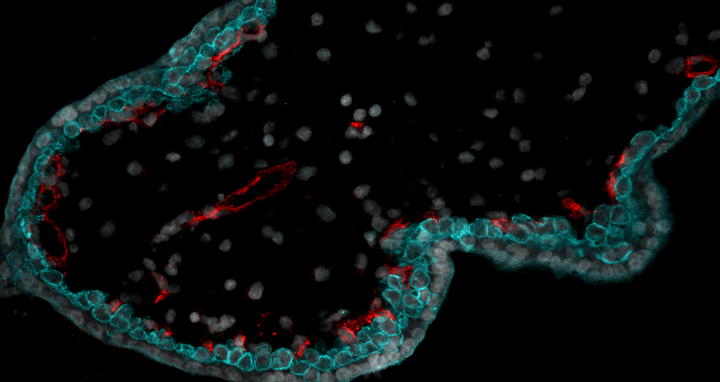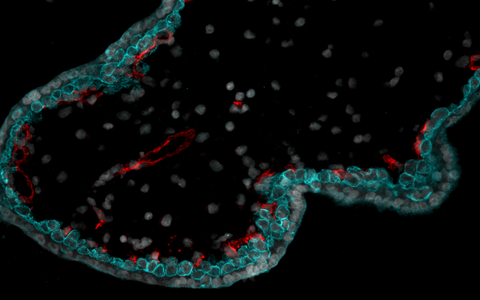Research at the ECRC wins three awards
With its Paul Dudley White International Scholar Award, the American Heart Association (AHA) recognizes groundbreaking research conducted by scientists around the world. The award-winning scientific publications are those that received the highest ranking at the Hypertension Scientific Sessions 2021. This year’s winners for Germany and Austria include researchers from the Experimental and Clinical Research Center (ECRC), a joint institution of the Max Delbrück Center for Molecular Medicine in the Helmholtz Association (MDC) and Charité – Universitätsmedizin Berlin. Both studies, which have not yet been published, contribute to a better understanding of the underlying causes of diseases like hypertension.
Gut microbiome a key factor in many diseases
The ECRC research team led by Prof. Dominik Müller and Prof. Ralf Dechend has recently developed a new method to study the interactions between the immune system and the gut microbiome. Trillions of bacteria live in our intestines and can determine whether we stay healthy or get sick; some metabolites, for example, trigger inflammatory reactions in the body and can cause high blood pressure.
But this information only gives us a rough idea of the conditions at their site of action.
Scientists often conduct indirect analyses of this bacterial metabolic interaction using stool or blood samples. “But this information only gives us a rough idea of the conditions at their site of action,” explains lead author and doctoral student Ellen Avery from the Müller/Dechend Lab. Using a newly developed technique, the team succeeded in isolating interstitial fluid – which fills the space between the cells in the tissue crevices – from different intestinal sections of rats and mice. Avery explains that this makes it possible to measure the interaction between host and microbiome at the very site where intestinal cells absorb metabolites. All authors involved in this study have received the Paul Dudley White International Scholar Award for Germany.
How does preeclampsia develop?
Immunofluorescence staining of an early placenta at the 11th week of pregnancy: the placental cells, which form a barrier between maternal blood (white star) and fetal tissue are responsible for nutrient and gas exchange, are stained in turquoise (cytokeratin 7 staining). These so-called trophoblasts surround the fetal blood circulation, whose vessels can be seen in red (CD34) in the image.
Another of the research group’s studies provides insight into the development of trophoblasts – the placental cells that separate mother and child. About three to five percent of pregnant women develop preeclampsia, making it one of the most common diseases to occur during pregnancy. But doctors and scientists are still not entirely sure what causes the disease. If symptoms such as high blood pressure go untreated, this can result in damage to the organs, blood and nervous systems of both mother and child.
The research was conducted by lead author Dr. Olivia Nonn, formerly of the Medical University of Graz and now at the ECRC, together with Dr. Florian Herse and other scientists from Austria and Norway. For the very first time, they were able to use single-cell technologies to identify in vivo stem cells in the placentas of women in the early and late stages of pregnancy. In doing so, it became clear trophoblast development becomes dysregulated in women with preeclampsia. If important processes fail to function correctly at this stage, this can lead to the onset of the typical preeclampsia symptoms. For their work, the team was awarded the Paul Dudley White International Scholar Award for Austria.
Hormone that regulates blood pressure can act as a trigger
To date, we still do not fully understand which factors trigger hypertension. Dr. Olivia Nonn and her team conducted another study to explore this question. The research, which has already been published in the AHA journal Hypertension, has now gained Nonn the Dr. Sabine Oberhauser Prize for applied medical research.
What is interesting is that, in contrast to non-pregnant women, women in early pregnancy display an alternative renin-angiotensin system pathway.
The study suggests that a blood pressure-regulating hormone plays a central role in the early development of preeclampsia and has an effect on the hormonally active and nutrient-transporting trophoblasts. “What is interesting is that, in contrast to non-pregnant women, women in early pregnancy display an alternative renin-angiotensin system pathway,” explains Nonn, who has been working as a physician and postdoctoral researcher at the ECRC since September 2021. “This means the metabolic capacity and thus energy balance of the trophoblasts is altered in pregnancies with a risk of preeclampsia.” This year, the prize was awarded to three winners for three different studies and is endowed with a total of €10,000.
Text: Christina Anders
Further information
Literature
Abstract: Ellen G Avery et al. (2021): “Isolation Of Gastrointestinal Interstitial Fluid As A Novel Method To Capture Host-microbiome Crosstalk”. Hypertension; DOI: 10.1161/hyp.78.suppl_1.MP41
Abstract: Olivia Nonn et al. (2021): “Unravelling Cell-specific Interactions At The Preeclamptic Maternal-foetal Interface From Early To Late Pregnancy”. Hypertension, DOI:10.1161/hyp.78.suppl_1.27
Olivia Nonn et al. (2021): “Maternal Angiotensin Increases Placental Leptin in Early Gestation via an Alternative Renin-Angiotensin System Pathway”. Hypertension, DOI: 10.1161/HYPERTENSIONAHA.120.16425





